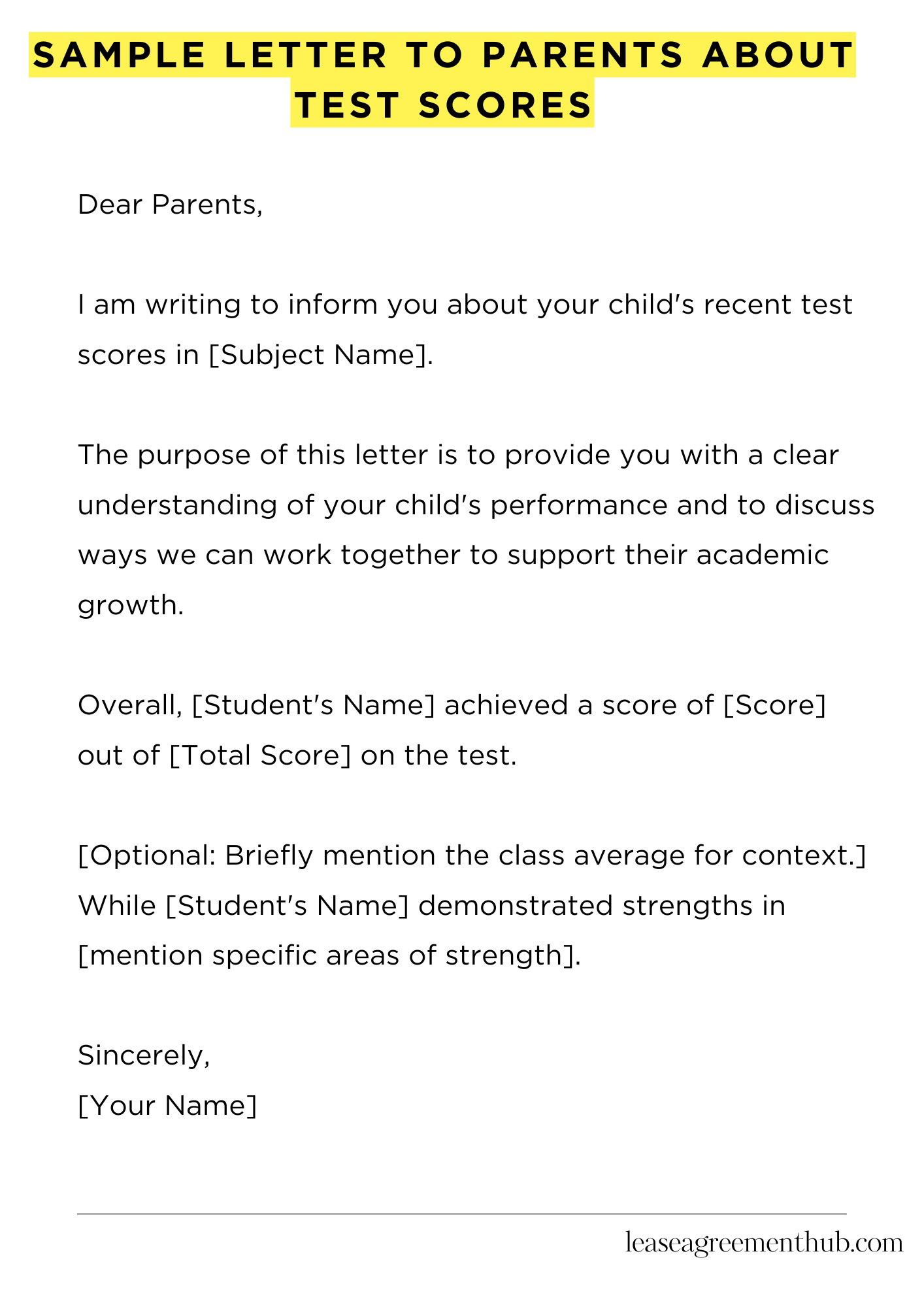Need to tell parents about their child’s test scores? A “Sample Letter To Parents About Test Scores” is your guide. Teachers and schools use these letters often. They communicate student performance clearly.
Writing these letters can be tricky. You want to be informative and supportive. That’s why we’ve gathered helpful examples. These samples make the process easier.
Ready to see some templates? We’ve got letters for all situations. Find the perfect fit and customize it today.
Sample Letter To Parents About Test Scores
[Date]
Dear Parents,
I am writing to inform you about your child’s recent test scores in [Subject Name].
The purpose of this letter is to provide you with a clear understanding of your child’s performance and to discuss ways we can work together to support their academic growth.
Overall, [Student’s Name] achieved a score of [Score] out of [Total Score] on the test.
[Optional: Briefly mention the class average for context.]
While [Student’s Name] demonstrated strengths in [mention specific areas of strength], there are areas where they could benefit from additional support. Specifically, [mention specific areas for improvement].
I encourage you to discuss these results with your child and emphasize the importance of continued effort and practice.
I am available to discuss these results in more detail and to collaborate on strategies to help your child succeed. Please feel free to contact me by email at [Your Email Address] or by phone at [Your Phone Number] to schedule a meeting.
Sincerely,
[Your Name]

How to Write Letter To Parents About Test Scores
Subject Line: Clarity is Key
- Craft a subject line that’s transparent and concise. Avoid ambiguity. Something like “Test Score Update: [Student’s Name] – [Subject]” works wonders.
- Steer clear of overly alarming language. Parents should feel informed, not panicked, even if the news isn’t stellar.
Salutation: Set the Tone
- Always use a formal salutation initially (e.g., “Dear Mr. and Mrs. Smith,”). Demonstrates respect and professionalism.
- If you have a rapport with the parents, transitioning to a more familiar greeting in subsequent correspondence is permissible, but start formally.
Introduction: The Overture
- Begin by stating the purpose of the letter directly. Example: “This letter conveys [Student’s Name]’s recent performance on the [Test Name] assessment.”
- Briefly mention the test’s objective or relevance to the curriculum. This provides context and underscores the test’s importance.
Body: The Nitty-Gritty
- Present the score clearly and unequivocally. Avoid obfuscation. Use percentages or letter grades, whichever is the school’s standard.
- Contextualize the score. Compare it to class average, previous scores, or benchmarks. This offers a comparative perspective.
- Offer specific observations regarding the student’s strengths and weaknesses demonstrated on the test. Pinpoint particular areas of acumen and areas needing amelioration.
- Avoid generalizations. Parents crave granular feedback, not platitudes.
Suggestions for Improvement: A Proactive Stance
- Provide concrete, actionable steps parents can take to support their child’s learning. Homework assistance, tutoring, or creating a dedicated study space are viable suggestions.
- Mention school resources available to the student, such as after-school programs, study groups, or teacher office hours.
- Emphasize collaboration. Invite parents to share their insights or strategies that have proven effective at home.
Maintaining a Positive Tone: The Guiding Principle
- Even when discussing suboptimal performance, maintain an optimistic and encouraging tone. Focus on growth and improvement, not solely on deficits.
- Acknowledge the student’s effort and potential. Reinforce the belief that improvement is attainable with concerted effort.
Closing: Seal the Deal
- Reiterate your willingness to collaborate and support the student’s academic journey.
- Provide your contact information (email and phone number) for easy communication.
- End with a professional and courteous closing, such as “Sincerely,” or “Best regards,” followed by your name and title.
Frequently Asked Questions About Sample Letters Regarding Test Scores
This section addresses common inquiries related to understanding and utilizing sample letters for communicating test score information to parents. It aims to provide clarity on the purpose, content, and appropriate use of these letters.
What is the purpose of a sample letter regarding test scores?
The primary purpose is to provide a template or example for educators to effectively communicate student test results to parents in a clear, concise, and professional manner.
What key information should be included in a letter about test scores?
Essential details include the student’s name, the name of the test, the date it was taken, the student’s score, and a brief explanation of what the score means in relation to benchmarks or expectations.
How can I ensure the letter is easily understood by parents?
Use clear, simple language, avoid technical jargon, and provide context for the scores. Consider including a visual aid or chart to illustrate the student’s performance.
Should the letter only focus on the test score itself?
No, it’s important to also include positive feedback about the student’s effort and learning progress, as well as suggestions for how parents can support their child’s learning at home.
Where can I find reliable sample letters about test scores?
Educational institutions, professional teaching organizations, and reputable online resources often provide sample letters that can be adapted for individual student needs.
Related: